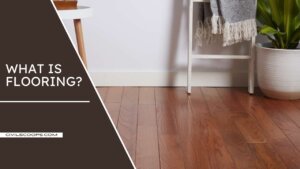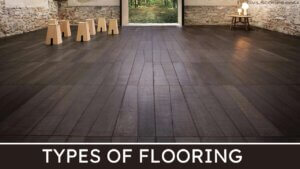All About Flooring | What Is Flooring | 11Types of Flooring.

Table of Contents
What Is Flooring?

The purpose of flooring is to get a good hard, level, and beautiful surface for living. The floors directly resting on the ground are known as ground floors while the floors of every storey are called upper floors. Apart from giving a good finished surface, these floors should have good damp resistance.
The ground surface is rammed well, along with a layer of red earth or sand is placed, which can be compacted. A layer of broken bricks, stones, etc. are provided up to 150 mm below floor finish level and rammed. While ramming, the surface is kept moist to get good compaction.
Then 1: 4: 8 concrete of 100 to 150 mm thickness is provided as base course. Over this bed, the floor finish is laid.
Types of Flooring

Different types of flooring are as follows.
- Mud and Moorum Flooring.
- Brick Flooring.
- Flag-Stone Flooring.
- Cement-Concrete Flooring.
- Terrazo Flooring.
- Mosaic Flooring.
- Marble Flooring.
- Tiles Flooring.
- Timber Flooring.
- Rubber Flooring.
- P.V.C. Flooring.
1. Mud and Moorum Flooring
These floorings are used in the low-cost home, specially in villages. On the hard coating of earth, filling mud or moorum layer is provided. The floor requires a thin wash of cow dung at least once a weak.
2. Brick Flooring
This is also a cheap floor construction. It’s commonly utilized in godowns and factories. Bricks are laid flat or on edges. Bricks of very good quality ought to be used for the construction. Brick-layer is provided on a sand bed or onto lean concrete (1: 8: 16) bed. In both cases, joints have been rendered flush and finished with cement mortar.
3. Flag-Stone Flooring
Laminated sand-stones or slates of 20 mm to 40 mm thick at the kind of slabs of 300 mm × 300 mm or 450 mm × 450 mm or in the kind of rectangles of size 450 mm × 600 mm are used as floor finishes. The stone slabs have been laid on 20 to 25 mm thick mortar spread over a concrete bed. The joints must be finished with rich mortar.
4. Cement-Concrete Flooring
It’s a modestly cheap and durable floor and therefore, commonly used in residential, commercial, and industrial buildings. It consists of two courses-base courses and wearing a coat. The base course is laid within well-compacted soil.
Its thickness is usually 75 mm to 100 mm. It consists of a lean cement concrete mix (1: 4: 8) or lime concrete containing 40 percent of 1: 2 lime mortar and 60 percent of the coarse aggregate of 40 mm size. After base coarse is hardened, wearing a coat of 40 mm is laid. It consists of panels of 1 m × 1 m, 2 m × 2 m, or 1 m × 2 m.
Alternate panels are laid with 1: 2: 4 concrete using wooden, asbestos or glass strip separators of 1.5 mm to 2.0 mm thickness. To get a good bond between base coarse and wearing coat cement, a slurry wash is given before laying wearing coat panels.
After 3–4 days of laying one set of the panel, another alternative panels have been laid. Top of these panels is finished by tamping the surface with wooden floats and tapping with trowels, till cement slurry appears on top. It needs curing for 7 to 14 days. To get a good appearance many times, a red-oxide finishing coat is provided.
5. Terrazo Flooring
Terrazo finishing coat is applied over concrete flooring to get a pleasing appearance. Terrazo finish consists of 75 to 80 percent of surface marble chips embedded in cement mortar. Marble chips are mixed in cement at the ratio 1: 1.25 to 1: 2, and about 6 mm terrazo toppings are laid. The top is tamped and rolled.
Additional marble chips have been spread during tamping to get a proper distribution of marble chips onto the surface. After drying it for 12 to 20 hours, it’s cured for 2–3 days.
- Then grinding is made in the following three steps:
- Ist grinding—Using coarse grade carborundum stones.
- IInd grinding—Using medium grade carborundum stones.
- IIIrd grinding—Using fine grade carborundum stones.
- Plenty of water is used during grinding. After each grinding cement
- Plenty of water is used during grinding. After each grinding cement grout of cream-like consistency is applied and cured for 6–7 days.
After final grinding and curing, the floor is washed with plenty of water and then with dilute oxalic acid solution. Then the floor is
finished with polishing using machines and wax polish.
6. Mosaic Flooring
It is made up of a finishing coat of small pieces of broken tiles of China glazed or of marble arranged in different patterns set in lime-surkhi or cement mortar. The base coarse is concrete flooring, and onto it, 30 to 40 mm mortar layer is provided.
With this particular mortar layer, broken pieces of china, glazed or marble, are set to get different attractive patterns. Following 20 to 24 hours of drying, the top is rubbed with a carborundum stone to get a smooth and polished surface.
7. Marble Flooring
Marble slabs are cut to get marble tiles of 20 to 25 mm thickness. They’re laid on floors similar to other tiles. Using a power-driven machine, the surface is polished to get shining and even surface. This type of flooring is commonly used in temples and hospitals.
8. Tiles Flooring
This is an alternative to terrazo flooring, used commonly used in residential, office, and commercial buildings. Tiles of clay, cement, or terrazo of standard sizes are manufactured in factories under controlled conditions.
On the concrete base, 25 mm to 30 mm thick mortar is laid, and these tiles have been placed and pressed using a trowel or wooden mallet. Before placing tiles, care is taken to see that the neat cement slurry is applied to the bottom side and sides of tiles to get a good bond.
Next day joints have been cleaned of loose mortar and raked up to 5 mm depth. Then that’s filled with a coloured cement slurry to get a uniform colour on the top surface. After curing for 7 days polishing and grinding are made as in the case of terrazzo flooring.
9. Timber Flooring
Timber flooring is used in dancing halls and in auditoriums. Timber plates might be directly placed on a concrete bed or might be provided over timber frame-work. In the latter case, it’s necessary to provide proper ventilation below the floor. This flooring is costly.
10. Rubber Flooring
Tiles or sheets of rubber with fillers like cotton fibers, asbestos fiber, or granulated cork are manufactured in a variety of patterns and colours. These tiles or sheets might be fixed to concrete or timber floors. These floors are attractive and noise proof. But they are costly.
11. P.V.C. Flooring
Poly-Vinyl-Chloride (PVC) is a plastic that’s available in different colour and shade. These days, tiles of this material are used widely. Adhesives are applied on a concrete base as well as on the bottom of PVC tiles. Then the tile is pressed gently with a 5 kg wooden roller till the oozing of adhesive is seen.
The oozed out adhesive is wiped, and the floor is washed with warm soap water. The floor finish is smooth, attractive, and can be easily cleaned. But it’s slippery and costly.
[su_box title=”FAQ” style=”default” box_color=”#333333″ title_color=”#FFFFFF” radius=”3″ class=”” id=””]
What Is Flooring?
Flooring is the general term for a permanent covering of a floor, or for the work of installing such a floor covering. Floor covering is a term to generically describe any finish material applied over a floor structure to provide a walking surface.
What Is Laminate Flooring?
Laminate flooring is a multi-layer synthetic flooring product fused together with a lamination process. Laminate flooring simulates wood with a photographic applique layer under a clear protective layer. The inner core layer is usually composed of melamine resin and fiber board materials.
What is LVT floor?
LVT flooring, (luxury vinyl tile), is the ideal combination of everything a commercial flooring product should be – elegantly designed, highly durable, and easy to maintain.
What Is Engineered Hardwood?
Engineered wood, also called mass timber, composite wood, man-made wood, or manufactured board, includes a range of derivative wood products which are manufactured by binding or fixing the strands,
What Is LVP Flooring?
LVP, or Luxury Vinyl Plank, is a durable, affordable, and beautiful alternative to hardwood flooring. It’s well-suited for a variety of residential and commercial applications, and, when installed correctly, perfectly mimics the look, texture, and warmth of real wood.
[/su_box]
[su_note note_color=”#F2F2F2 ” text_color=”#333333″ radius=”3″ class=”” id=””]
Like this post? Share it with your friends!
Suggested Read –
- All About Formwork Failure | What Is Formwork Failure | Causes of Formwork Failure
- All About Plywood | What Is Plywood | What Is Plywood Used For | What is Plywood Made From
- All About Consider | When Building a New Home | Important Factors to Consider When Building a New Home
- All About Flagstone | Introduction of Flagstone | What Is Flagstone | What Is a Flagstone Patio | Types of Flagstone
- All About Painting | What Is Painting | Painting Area Calculation for Evan Surface & Uneven Surface |How Much Paint Do I Need
[/su_note]
Originally posted 2022-06-18 13:02:57.
